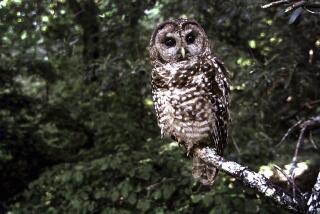Volunteers Needed to Answer Call of Wild : Animals:As many as 3,000 baby birds will become homeless or injured this spring. Project Wildlife helps them take wing by providing foster parents.
- Share via
March kicks off the season when thousands of young songbirds are left orphaned because they have either fallen or been accidentally knocked out of their nests.
To help the birds, Project Wildlife is seeking volunteers to become foster parents to as many as 3,000 young birds, said spokeswoman Lyn Lacye.
Project Wildlife is a San Diego-based nonprofit group made up of volunteers who help sick and injured wild animals recover before returning them to their environment.
“Spring is baby season because of the birds and the bees and all . . . so you get a lot of babies,” Lacye said.
The songbird births come at a time when home gardeners and city work crews begin pruning trees. As a result, nests filled with baby birds are often displaced, making it difficult for the parents to find the young birds and continue caring for them, Lacye said.
The birds are often at risk of dying because of the lack of food or because larger animals get to them.
A majority of the birds Project Wildlife gets from March to August are young songbirds from all areas of the county.
Meryl Faulkner, a volunteer who works with both songbirds and sea birds said, “We get calls from people who get baby birds from the ground, and we always try to get people to put them back in the tree or at least in the same general area.”
Many people have the erroneous belief that if a person touches a baby bird the parents will no longer want it, Faulkner said.
“That is not true,” she said. “Birds have no sense of smell.”
Other times it is impossible to return the birds to their nests and the young are turned over to Project Wildlife, Faulkner said.
“Some people say, ‘Well, let nature take its course,’ but there is no way you can leave them there,” Faulkner said. “They’ll be cat food.”
Project Wildlife, which is licensed by the California Department of Fish and Game to care for injured and orphaned animals, takes in several thousand birds and mammals each year, Faulkner said.
At times, Faulkner has had as many as 50 young songbirds to care for at one time, feeding them dissolved cat food on wooden coffee stirrers.
That can be a daunting task, considering the birds must be fed every 30 to 45 minutes from about 7 a.m. to about 7:30 p.m. daily.
The hand feedings go on for about three weeks or until the birds can feed themselves, Faulkner said. The final step before putting the birds back in the wild is to send them to an aviary where they can practice flying while being monitored.
The total process takes six to eight weeks, Faulkner said.
“It is really fascinating to watch them,” said Faulkner, who has cared for about 4,500 birds of different types since she began working with Project Wildlife 15 years ago. “It’s just really interesting to sort of spy on them.”
Project Wildlife receives animals from all over San Diego County. Once Project Wildlife gets the call from a community member or another organization, a volunteer picks up the animal and takes it to another volunteer, who has been trained by other, more experienced members, and nurses it back to health, Lacye said.
Birds are taken to one of two places: to a home or to the Project Wildlife facility located near the San Diego Humane Society near Custer and Sherman streets in the Bay Park area.
Volunteers can work in several areas, Lacye said.
They can work with the baby songbirds at home in the early stages, or, if they have tighter schedules, they can help by taking birds that have become what Lacye referred to as “adolescent” birds. These birds can feed themselves and can be kept in cages without a great deal of supervision, although they do need to be monitored to make sure any injuries have healed properly and that they are eating well.
Others are needed to answer phones, Lacye said. Using a call-forwarding system, people can receive calls and relay the information to other volunteers without ever leaving their homes. People are also needed to work at Project Wildlife itself.
“It is terribly rewarding,” Lacye said. “After five hours, you feel needed.”
Project Wildlife works year round and not just with songbirds.
On a recent day, Faulkner was caring for a house finch that had been brought in with a broken leg and a blackbird that had probably been struck by a car and had balance problems resulting from a concussion.
Faulkner also had doves, sparrows and orioles in a small aviary in one corner of her La Jolla home’s back yard.
Most were in the final stages of their rehabilitation. Some, like the orioles, were waiting for other orioles to arrive before they could be released, Faulkner said.
Faulkner also had several sea birds--including Western grebes, least terns, skimmers and loons--living in kennels in her garage and back yard.
“Every time a storm comes, we can expect to get some sea birds,” Faulkner said. Some are not injured but have parasites that have made them weak. But most recover and go back to their homes by the sea.
More to Read
Sign up for Essential California
The most important California stories and recommendations in your inbox every morning.
You may occasionally receive promotional content from the Los Angeles Times.













